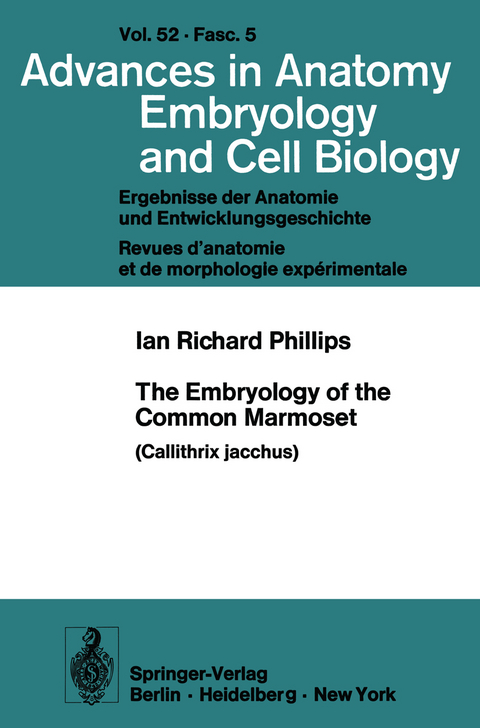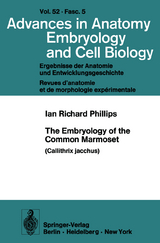The Embryology of the Common Marmoset
Callithrix jacchus
Seiten
1976
Springer Berlin (Verlag)
978-3-540-07955-2 (ISBN)
Springer Berlin (Verlag)
978-3-540-07955-2 (ISBN)
The primates represent a diverse group with the phylogenetic relationships of the var ious species reflected in their early embryonic development. The members of the Tupaiidae, Lemuridae and Lorisidae show great similarities to the lower mammals and even birds. The Tarsiidae represent an intermediate step and the Platyrrhini and Catarrhini exhibit the greatest similarities to man. During the period of embryogenesis, the dimensions of an embryo are insufficient guide to its age and much more reliable information can be derived from a study of its external form and internal structure. Examination of embryological specimens from a variety of simian species dates back to the early 1900's but much of this material was collected in a haphazard way from animals shot in the wild. Heuser and Streeter (1941) depicted a series of embryos of the rhesus monkey (Macaca mulatta) and correlated their gestational age with external form and size. Streeter (1951) arranged human em bryos, between 24. ± 1 and 47. ± 1 days of post-ovulation age, into age groups or devel opmental horizons based on their external form and internal structure. Each horizon was two days apart and numbered XI to XXIII. The transition from embryo to fetus occurred at the end of horizon XXIII and was arbitrarily dermed as the point where bone marrow invaded the cartilaginous precursor in the humerus. The earlier stages I-X have been dermed subsequently, (Heuser and Corner, 1957; O'Rahilly, 1973).
Material and Methods.- Animals.- Breeding Techniques and the Estimation of Embryonic Age.- Collection and Processing of Embryos.- Hysterotomy Technique.- Limitations to Surgical Procedures.- Dissection and Processing.- Records.- Observations.- Description of Stage VII.- Description of Stage VIII.- Description of Stage IX.- Description of Stage X.- Description of Stage XI.- Description of Stage XIII.- Description of Stage XIV.- Description of Stage XV.- Description of Stage XVI.- Description of Stage XVII.- Description of Stage XIX.- Description of Stage XXI.- Discussion.- Summary.- Acknowledgements.- References.
| Erscheint lt. Verlag | 1.11.1976 |
|---|---|
| Reihe/Serie | Advances in Anatomy, Embryology and Cell Biology |
| Zusatzinfo | 48 p. 5 illus. |
| Verlagsort | Berlin |
| Sprache | englisch |
| Maße | 155 x 235 mm |
| Gewicht | 120 g |
| Themenwelt | Medizin / Pharmazie |
| Naturwissenschaften ► Biologie ► Genetik / Molekularbiologie | |
| Naturwissenschaften ► Biologie ► Zellbiologie | |
| Schlagworte | animals • Development • Embryo • Embryology • Fetus • Marmoset |
| ISBN-10 | 3-540-07955-6 / 3540079556 |
| ISBN-13 | 978-3-540-07955-2 / 9783540079552 |
| Zustand | Neuware |
| Haben Sie eine Frage zum Produkt? |
Mehr entdecken
aus dem Bereich
aus dem Bereich
50 Meilensteine der Genetik
Buch | Hardcover (2022)
Librero b.v. (Verlag)
CHF 13,90




